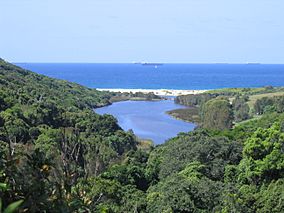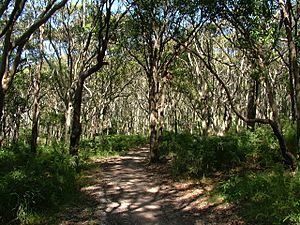Glenrock State Conservation Area facts for kids
Glenrock State Conservation Area is a special protected area in Australia. It's about eight kilometers south of Newcastle in New South Wales. This park covers 534 hectares (that's like 1,300 football fields!). It stretches from Merewether to Dudley along the coast.
Glenrock is important for many reasons. It has rare plants and animals, and many old sites that show its history. Both Aboriginal people and early European settlers have left their mark here. The park is located in the traditional lands of the Awabakal people.
Contents
Discover Glenrock Park
This park offers many amazing features. It has beautiful natural scenery and important cultural history. People also visit for fun activities and to learn more about nature.
Glenrock Lagoon is a pretty water spot inside the park. It gets its water from Flaggy Creek. The lagoon connects to Burwood Beach and the ocean through a small channel.
Why is Glenrock Protected?
Glenrock is a "state conservation area." This means it's protected by law to keep its plants, animals, and cultural sites safe. It also allows people to visit and enjoy the park in ways that don't harm nature.
Fun Activities at Glenrock
Many different people enjoy Glenrock Park. There are lots of walking tracks, some even good for wheelchairs. The famous Great North Walk goes right through the park.
Glenrock is super popular for mountain biking on special trails. You can also go horse riding in some areas. Other fun things to do include hang gliding, fishing, surfing, and beach activities. There's even a Scouts Australia camp next to Glenrock Lagoon!
Amazing Plants of Glenrock
Glenrock Park is home to many unique plants. It has rare plant groups and even two types of "endangered ecological communities." These are groups of plants that are very rare and need protection. The park also protects five types of plants that are threatened.
Rare Plant Communities
The park has native plants that are hard to find elsewhere. This is because much of the land around Newcastle has been changed by people. Glenrock has twelve different plant communities. Eight of these are considered very rare across Australia.
Some special plant communities include:
- Littoral rainforest (found near the coast)
- Permian coastal clay grassland (grasslands on special clay soil)
- Permian sheltered dry forest (forests in protected spots)
Protecting Littoral Rainforest
Glenrock Park protects some of the last remaining Littoral Rainforest in the lower Hunter area. This type of rainforest is critically endangered. This means it's at very high risk of disappearing forever. The park helps keep these important rainforests safe.
Endangered Plants to Spot
Five endangered plants live in Glenrock Park. They are:
- Rough double tail (Dirius praecox)
- Magneta lilly pilly (Syzygium paniculatum)
- White-flowered wax plant (Cynanchum elegans)
- Black-eyed susan (Tetratheca juncea)
- Heath wrinklewort (Rutidosis heterogama)
These plants are protected by law. For example, the black-eyed susan used to grow in many places, but now it's only found in a small area. The park helps these plants survive. The magneta lilly pilly is a rainforest tree. It's only found in small groups, often with fewer than 20 trees. Protecting these areas helps them keep growing and making seeds.
Wildlife of Glenrock
Glenrock State Conservation Area is a home for many different animals. Over 140 types of birds have been seen here! This includes many threatened species.
Threatened Birds
Some important threatened birds found in the park are:
- Powerful owl (Ninox strenua)
- Masked owl (Tyto novaehollandiae)
- Turquoise parrot (Neophema pulchella)
- Regent honeyeater (Xanthomyza phrygia)
- Swift parrot (Lathamus discolour)
The swift parrot is a special bird that migrates. It breeds in Tasmania and then flies to mainland Australia for winter. Glenrock Park is an important stop for these birds, especially when food is scarce elsewhere.
The regent honeyeater is another endangered bird. Its numbers have dropped a lot because its habitat is disappearing. These birds love the spotted gum trees in Glenrock Park when they are flowering.
Other Animals in the Park
You might also see some cool reptiles in Glenrock, like:
- Diamond python (Morelia spilotes var. spilotes)
- Death adder (Acanthophis antarticus)
- Tiger snake (Notechis scutatus)
- Brown snake (Pseudonaja textilis)
- Land mullet (Ergenia major)
Mammals living here include:
- Short beaked echidna (Tachyglossus aculeatus)
- Long nosed bandicoot (Parameles nasuta)
- Sugar glider (Petaurus breviceps)
- Brown antechinus (Antechinus stuartii)
- Common dunnart (Sminthopsis murina)
Some threatened mammals also call Glenrock home. These include the common bent wing bat, little bent wing bat, and the squirrel glider. The grey-headed flying fox, which is nationally threatened, also uses the park.
Why Glenrock is Important for Animals
Glenrock is a vital refuge for animals that need large areas to live. The powerful owl, for example, needs a huge home range (over 1,500 hectares) with big trees for roosting and plenty of prey. The grey-headed flying fox also needs a large area to find food. Since much of the land around the park is developed, Glenrock provides a crucial safe space for these animals.
Glenrock's Rich History
Glenrock State Conservation Area is part of Awabakal Country. It's believed people have lived here for thousands of years. The land is very important to the Awabakal and other Aboriginal people. Many ancient sites have been found, like shell middens (old food scraps), axe grinding spots, campsites, and a quarry.
European history is also strong here. You can find:
- Australia’s first road/tram tunnel (built around 1846)
- Australia’s first railway tunnels (built around 1861 and 1862)
- Remains of Australia’s first copper smelter (from around 1851)
- Remains of the Burwood Colliery (an old coal mine) and a coastal railway.
These early coal mining sites are so important they are listed on the NSW State Heritage Register. In total, there are over 145 known historical sites in the park!
Challenges Facing Glenrock
Glenrock State Conservation Area faces some challenges. Things like past mining, building new roads, and even some recreational activities have harmed the park.
Current Threats
Some of the main threats today include:
- Soil erosion: When soil washes away, often from poorly designed trails.
- Water pollution: From city stormwater and sewage pipes.
- Introduced plants and animals: Weeds and pests that don't belong here.
- Fire management: Not having the right amount of natural fires can harm the forest.
- Climate change: Changes in weather patterns can affect the park.
Bell Miner Dieback
One sign of stress in the forest is something called "bell miner associated dieback." This is when trees get sick and die, often linked to bell miner birds. It happens when the forest is stressed, maybe from not enough fires or too many weeds. The park has a plan to help the forest recover.
Weeds in the Park
Several types of weeds grow in the park. These include bitou bush, lantana, and blackberry. Bitou bush is a big problem, especially along the coast. It spreads quickly and harms the endangered plant communities and threatened species. The park has a plan to remove these weeds.
Managing Glenrock Park
The NSW National Parks and Wildlife Service manages Glenrock State Conservation Area. There's also a sewage treatment plant and electricity lines in the park, managed by other companies.
A special plan, called the "Plan of Management," guides how the park is looked after. This plan explains what's special about the park, how to protect it, and how people can visit and learn.
The main goals of managing the park are:
- To reduce the harm from threats like weeds and pollution.
- To manage the many activities that happen in the park.
- To protect the park's natural beauty and cultural history.
Local councils also work with the park managers to make sure everyone helps protect this special place.



